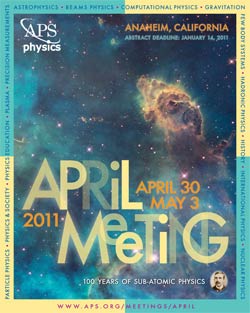FIP Sessions at the APS 2011 Spring Meetings - Overview
Harvey Newman
One of the major undertakings of FIP is the organization of the sessions at the March and April meetings. This year we had very interesting and informative invited sessions on a wide-ranging set of issues, including four invited sessions at the March meeting in Dallas and three invited sessions at the April meeting in Anaheim.
As reviewed elsewhere in this issue, many of FIP's key themes, from the challenges facing young and women physicists to governmental research for science, to international collaborations in major science projects, to global issues such as the growing Digital Divide and restrictions on critical materials, and science diplomacy, were well- represented at our invited sessions at the 2011 March and April meetings. In addition, as an experiment that turned out to be successful, FIP was pleased to accept contributed talks under a new sorting category entitled "International Programs, Collaborations and Exchanges".
The contributed session (V24) at the March meeting, chaired by Gloria Lubkin of AIP, editor emerita of Physics Today, and co-sponsored with the Forum on the History of Physics, included talks on US-Finland cooperative research as well as an historical review of the first female African American physicist.
The FIP contributed session at the April meeting that I chaired (Q13) covered a broad range of topics, from monitoring antineutrino fluxes for nonproliferation to the use of underground physics laboratories for other scientific applications, to the evolving modes international collaboration, to the biennial Rainbow School of physics in Africa, that aims to “build capacity to harvest, interpret, and exploit the results of current and future physics experiments with particle accelerators, and to increase proficiency in related applications.” Following this initial success, we will continue to encourage FIP members to contribute talks in this category at future APS meetings.
At the March meeting, session B8 "Critical Materials for Global Science and Technology" chaired by Bill Barletta, explored the impending threat of exhaustion of key materials, from Helium-3 to Lithium to Tellurium, that drive progress in our modern world. This trend, with multiple causes from the rising demand of emerging economies to the highly localized concentration of some elements, has remained below the radar for the population at large, as well as the majority of the physics community.
In the evening of Tuesday March 22, there was a Joint Reception co-hosted by FIP, the Office of International Affairs, the Overseas Chinese Physics Association (OCPA), the American Chapter of the Indian Physics Association (ACIPA), the Iranian-American Physicists Group Network (IrAP), and the Association of Korean Physicists in America(AKPA).


Disclaimer - The articles and opinion pieces found in this issue of the APS Forum on International Physics Newsletter are not peer refereed and represent solely the views of the authors and not necessarily the views of the APS.
